解析多人游戏关卡设计之地图设计规则
作者:Pascal Luban
本系列文章第1部分的主题是多人游戏关卡设计,通过与单人关卡的比较深入探究多人关卡面临的典型设计局限性。
优秀多人关卡地图设计应当克服以下3个挑战:
1、耐用性。地图可以玩上数千次而不让玩家感到乏味。地图必须持续提供战术挑战。
2、易用性。地图中的导航应当清晰。记住,对于新玩家来说,复杂的地图设计本身就是个难题。
3、娱乐性。这个需求是显而易见的,但是却很难确定其规则。
挑战1:耐用的地图
先来分析地图的耐用性。哪些关卡设计规则可以克服这项挑战呢?
1、我首先要推荐的是,合理使用第三维度,这或许也是最为重要的规则。利用和开拓地图的垂直维度,给予玩家使用地图容积的理由,不要单纯使用二维布局。
以下范例是出现在《细胞分裂:明日潘多拉》和《细胞分裂:混沌理论》中的博物馆地图。运用这个规则,可以在这个中型房间中利用移动和伪装创造出丰富的游戏玩法。玩家可以在地图中垂直移动,比如攀爬楼梯和柱子,或从高处跳下。房间中还有许多可供玩家藏匿的物体,也可以利用这些物体来弹射手榴弹。
(《细胞分裂:明日潘多拉》和《细胞分裂:混沌理论》中的博物馆地图合理利用了第三维度。)
这个规则也可以运用到外部场景中,比如在《战地》的地图中,玩家可以爬上屋顶、起重机或高塔,也可以乘坐飞行交通工具。
2、接下来,我要推荐的方法是,构建开放地图,增加玩家可以选择的移动路径。仓库、工厂或其他类型的建筑可以使用这种类型的地图。
以《细胞分裂:明日潘多拉》和《细胞分裂:混沌理论》多人版中发布的Deftech地图为例。虽然内庭院的设计简单,但是玩家的移动路径选择非常多。地图中包含3个主移动路径,分别是院子、人行桥和集装箱顶,还有2个次移动路径——地下网状隧道和庭院上空的电缆。这些不同的移动路径丰富了移动可能性,从而增加了可采用的战术数量。因而,Deftech庭院成为死亡竞赛粉丝最钟爱的地图之一。
(《细胞分裂:明日潘多拉》中Deftech地图庭院显示户外场景中同样可以创造垂直移动。)
3、增加地图中事件的数量,尤其是那些让玩家改变策略的事件。《细胞分裂:混沌理论》中的Aquarius地图便是事件使用的绝妙例证。在我的上篇文章中,我解释过在这个地图中防御者某些不妥的动作可能为攻击者的渗透提供新的机遇。然而,Aquarius还提供了其他直接影响玩家战术的地图事件。
攻击者每次到达地图中的任务目标时,他们都会触发对防御者不利的地图事件,比如释放烟雾、门锁开启和灯光熄灭等。《细胞分裂:混沌理论》中所有的地图都带有此类互动,其中有两个地图还可以用于《细胞分裂:明日潘多拉》中。调查显示,玩家确实很欣赏这种额外维度的游戏玩法。
游戏设计本身必须为地图的耐用性做出贡献,可以通过设定关卡设计中特别元素的功能来实现。在《孤岛惊魂》多人版的Assault模式中,工程师可以在预定地点构建防御工事或炮塔。当关卡设计为这些战术性举措提供施展地点时,游戏设计就变得更有意义。炮塔可以防守路口,墙体可以阻挡进攻口,这样防御者就可以将注意力集中在敌人的其他进攻口上。
(《细胞分裂:混沌理论》中Aquarius地图某房间出于正常状态下。光照充足,攻击者可以找到的藏身之处并不多。对防御者来说,这样的房间相对较安全。)
(攻击者抵达任务目标之一后的房间状态。弥漫的烟雾使防御者的处境更加危险。)
挑战2:导航清晰的地图
多人地图设计师需要克服的第2个挑战是易用性。对首次接触新地图的玩家来说,这是他们面临的主要问题,尤其是新手玩家。设计师需要明白,压力和游戏节奏会影响玩家对场景做出恰当的分析。
关卡设计师的目标就是,无论玩家身处地图何处都能够回答3个基本问题:我身在何处?我应当前往何处?我要如何到达目标地点?
我身在何处?
玩家应当可以通过观察周围的环境来判断当前所处位置以及在地图中的方位。在《细胞分裂:明日潘多拉》中,Krauser Labs地图有3个藏匿任务目标的房间。这些区域的装饰颜色各不相同。因而玩家很容易就可以判断出自己的当前位置并找到合适的通道。
在外景地图中,让玩家断定所处位置依然是件很简单的事情,可以通过增添远距离可视的场景元素,比如这个《光晕2》中的多人地图。
第2种可以采用的技术是构建不对称地图或区域。我的团队中有个关卡设计师利用《细胞分裂:明日潘多拉》中的免费关卡编辑器制作了地图Long Run,地图平面倾斜,像是个巨大的楼梯。通过自身位置与地图中其他楼层的对比,玩家就可以迅速明白自己所处的位置。
(在《光晕2》的这个地图中,所有地方可以看到塔,玩家很容易就能够判断出自己的位置。)
(Long Run虽然复杂,但不对称设计使导航变得简单。)
第3种是在地图中设置清晰的障碍物,如下图所示。
我应当前往何处?
我们刚刚讨论了部分可帮助玩家判断自己在地图中位置的技术。现在我们来看看如何帮助玩家找到实现任务目标的方向。
许多多人游戏都会要求玩家实现某种目标,比如获得旗帜、放置炸弹或攻击终端电脑。玩家应当能够通过简单地分析地图布局来识别和猜测目标的位置。
应当运用2条规则:
1、任务目标或相关场景元素应当是远距离可视物体
2、任务目标本身应当与周围环境有显著的区别
《战地》中的旗杆设计完美运用了这两条规则。如果游戏中的目标是放置炸弹之类的任务,可以在地点附近的物体上添加标志。
(《战地》中的游戏目标相当显眼。)
现在我们已经看到,户外游戏目标的设计相当简单。室内目标设计更为复杂,因为墙体会阻挡玩家的视线。这个问题的解决方案是,在地图布局和目标间创建显而易见的连接。比如,地图分为3个区域,其中每个区域都含有一个目标。只要玩家掌握了这种规律,将其引向目标就变得更为容易。室内目标设计的第2个规则是,任务目标与周围环境有一定的差别,这会直接将玩家引向目标。
《细胞分裂:明日潘多拉》的Deftech地图成功运用了这些规则。任务目标分布在3个独立的建筑物中。它们都位于底层。虽然游戏的地图很大,但是在游戏测试中几乎没有出现导航问题。我曾经观看过该地图的测试,发现玩家很快便学会导航,正确地找到任务目标。
最后,我要说的是自己对使用图标来帮助导航的做法的看法。我们在《细胞分裂:明日潘多拉》和《细胞分裂:混沌理论》中大量使用这种方法,但它们的有效性确实值得商榷。事实上,在室内地图中,图标指出的最短路径往往需要玩家穿墙。这些图标或许有一定用处,但并非导航问题的绝妙解决方案,而且满屏的图标可能会让玩家感到心烦意乱。
我要如何到达目标地点?
目标导航还有个挑战:帮助玩家理解他可以通过哪些途径到达任务目标地点。最佳的解决方案是,同时向玩家展示目标和到达目标地点的方法。方法之一是设计大小中等的地图,让攻击者可以看到地图全景。下图便是River Mall地图,这是《细胞分裂:明日潘多拉》Xbox版本的流行地图,攻击者从首个区域顶端进攻。这样,他们可以看到有图标标志的任务目标和通向目标的所有路径,包括楼梯和人行桥等。
(《细胞分裂:明日潘多拉》和《细胞分裂:混沌理论》地图River Mall中,攻击者可以同时看到他们的游戏目标和获得路径。)
挑战3:有趣的地图
对我们来说,最大的挑战是创造地图的趣味性。如果都采用上述部分描述的规则,那么所有地图之间将极为相似,但玩家希望在地图中看到惊喜和挑战。玩家的想法是,拥有大量相似的地图还不如只有少量多样化地图。
我的首个建议是,尽可能地让地图多样化。在《细胞分裂:混沌理论》中,我们将探索原创图像主题视为关键部分。Aquarius地图呈现的是海洋博物馆,Orphanage的场景是森林中荒废的学校,Missile Strike的主题是古老的复杂地堡。
但是,仅仅将图像主题多样化是不够的。各地图游戏玩法差异化设计也是必要的。幸亏我们在游戏设计方面有丰富的经验,为多人地图赋予不寻常玩法的目标才得以实现。每个地图都会强迫玩家在作战中采用特定战术。以下内容总结了《细胞分裂:混沌理论》中某些地图游戏玩法方面的主要特征。
《细胞分裂:混沌理论》发布1年后,没有一个地图被玩家抛弃。
我的第2个建议是,在地图中设置只有对游戏精通才能发现的秘密或动作。地图的这个层面特别吸引资深玩家,而这正是游戏的目标用户。
《孤岛危机》中有某些理想的狙击手隐蔽点,他们可以靠草木隐藏起来。在《细胞分裂:混沌理论》中,我们设计了某些特别地点,供间谍在执行最吸引人但最危险的攻击任务时使用,比如将雇佣兵撞下人行桥。Factory地图的任务目标只有在两名攻击者合作开展动作才可以触及,这在Versus多人模式中是种危险的行为。
我的第3个建议是规划许多地图事件,比如移动元素或可破坏背景物体。这些事件必须对游戏玩法目标做出响应,否则它们只是徒增地图视觉效果而已。我在阐述Aquarius地图时已经提到了可以改变游戏玩法的地图事件,以下是其他可以使用的方法:
(在《细胞分裂:混沌理论》多人地图Club House中,攻击者正准备将防御者抛下栏杆。)
在Factory中,攻击者可以开动挖掘机毁坏墙壁,清理出前往新任务目标的路径(游戏邦注:见以下屏幕截图)。除了看起来很壮观外,从游戏玩法的角度上说,这种类型的事件也非常有趣。开动挖掘机就会使攻击者暴露在防御者的射程内,但是如果他的动作成功,那么就使防御者需要顾及的范围扩大,从而让队伍的胜利变得更加容易。
在Club House中,攻击者可以通过摧毁悬空式天花板或升降地板来开辟新路径,但是这么做也会让防御者发现他们的位置,防御者可能会向他们抛手榴弹。在Bank中,攻击者可以攻击主机来引起照明故障,让位于任务目标所处房间的防御者处于弱势。因为这些动作只能在主房间内做出,所以防御者必须做出艰难的选择:是防守这些次级目标,削弱任务目标的防御还是专注于防御后者,不顾对手的行为。
(在《细胞分裂:混沌理论》Versus模式多人地图Factory中,两个任务目标在游戏开始时无法获得。它们位于墙后。要摧毁墙,攻击者必须起动挖掘机。)
(如上图,只要挖掘机起动,墙壁就会被攻破,攻击者可以触及两个新的任务目标,同时使防御者所需防御的空间增加30%。)
基本上,《细胞分裂:混沌理论》的所有地图和那些可下载地图都包含此类事件。这种设计得到玩家的高度认可,《细胞分裂:明日潘多拉》和《细胞分裂:混沌理论》开发商Ubisoft Annecy studio在多人Versus模式中展现出关卡设计的天赋。
在下篇文章中,我将探讨地图场景和游戏系统的问题,围绕技术参数来设计多人游戏,使之可以为更多的玩家所接受。
游戏邦注:本文发稿于2006年11月8日,所涉时间、事件和数据均以此为准。(本文为游戏邦/gamerboom.com编译,拒绝任何不保留版权的转载,如需转载请联系:游戏邦)
Multiplayer Level Design In-Depth, Part 2: The Rules of Map Design
Pascal Luban
In the first part of my series devoted to the design of multiplayer levels, I offered a detailed view of typical design constraints in multiplayer compared to that of a single player level. I would now like to give some suggestions to remedy these problems with intelligent map design.
A good level design for a multiplayer map should respond to three challenges:
Durability. A map should withstand thousands of game sessions without letting players feel bored. It must provide continuous tactical challenge.
Accessibility. Navigation in a map should be clear. Remember that complex map design is one of the main difficulties a new player is confronted with.
Entertainment. This need is obvious, but its rules are difficult to define.
Challenge 1: Durable Maps
Let’s begin by the durability of the map. What are the level design rules that I recommend to respond to this challenge?
1.) My first recommendation, and probably the most important, is to put the third dimension to good use. Use and exploit the vertical dimension in your maps and give the players reasons to use the volume of the map and not only its two-dimensional layout.
The example below is taken from the Museum map, available in both Splinter Cell – Pandora Tomorrow and Chaos Theory. This medium sized room perfectly illustrates how a very rich gameplay, based on movement and dissimulation, can be created by applying this rule. Players have several partially overlapping circulation levels at their disposal. They can move vertically by using the stairs, climbing the beams or simply by jumping. Finally, the room includes enough objects to enable players to hide, but also to use these surfaces to make their grenades bounce.
(One of the rooms where the third dimension is well used in the Museum map (Splinter Cell – Pandora Tomorrow and Chaos Theory))
This rule may well be applied to exterior settings, too, such as in Battlefield maps, where the players can climb roofs, cranes or towers and can also take flying vehicles.
2.) My second recommendation is to build open maps to enable the creation of an infinite number of paths. The warehouse, plant or building site themes suit this kind of map perfectly.
Take for instance the Deftech map, published in the multiplayer version of Splinter Cell – Pandora Tomorrow and Chaos Theory. The inner courtyard, although a very simple design, provides a practically infinite number of movement possibilities. It contains three main levels of movement – the yard, the footbridge and the roof of the containers – as well as two secondary levels: a network of underground tunnels and overhead cables. By combining these different levels of movement, a significant variety of movements — and therefore of tactical possibilities — is obtained. It’s not by luck that Deftech yard is one of the most appreciated maps by deathmatch fans.
(The yard of the Deftech map (Splinter Cell – Pandora Tomorrow) illustrates how vertical movement is created in an exterior setting)
3.) Increase the number of events in the map, especially those that make the players change their tactics. The Aquarius map, available in Splinter Cell – Chaos Theory, is a good example of the use of events. In my previous article, I explained how certain ill-considered actions of the defenders open new possibilities of infiltration to the attackers in this map. But Aquarius also provides other map events that have a direct impact on players’ tactics.
Each time the attackers take over one of the five mission objectives of the map, they trigger an event in the map that handicaps the defenders: smoke release, unlocking of doors, lights turning off etc. All Splinter Cell – Chaos Theory maps, as well as the two maps available for download for Pandora Tomorrow, are full of interactions like these. Experience shows that gamers really appreciate this extra dimension of gameplay.
The game design itself must contribute to the map durability, by producing features that acquire their importance according to specific elements of level design. In the Assault mode of the multiplayer version of Far Cry, engineers can build fortifications or turrets in predetermined locations. This game design feature makes sense when the level design provides locations where these buildings offer a real tactical interest. Thus, a turret may cover an access path or a wall may block an entry to allow the defenders to concentrate on other entries.
(A room in the Aquarius map (Splinter Cell – Chaos Theory) in its normal state. It is well-lit and provides few hiding places for the attackers. It is a “safe” room for the defenders.)
(Here is how the same room looks when the attackers reached one of their mission objectives. The darkness of the smoke makes the room very dangerous for the defenders.)
Challenge 2: Maps Where Navigation Is Clear
The second challenge a multiplayer map designer should respond to is accessibility. It’s a major problem for players who discover a new map, and especially for beginners. Designers should keep in mind that the stress and the game rhythm decrease the player’s capacity to properly analyze the setting.
The objective of the level designer is to design the map in such a way that the player can always answer three basic questions, regardless of his location: Where am I? Where should I go? How do I get there?
Where Am I?
By looking at the environment, the player should be able to determine his current position and locate it on the map. In Pandora Tomorrow, the Krauser Labs map contains three rooms that shelter the mission objectives. Each of these areas is characterized by a different colour. It is therefore easy for the player to determine his current position and to guess where the passage leads him, thanks to the color light that filters through the entries to the areas in question.
In an exterior map, it is still simple to enable the player to determine where he is, by adding setting elements that are visible from a distance, as is the case in this multiplayer map of Halo 2.
A second technique consists in building asymmetrical maps or areas. Long Run, a map designed by one of the level designers of my team with the free level editor of Pandora Tomorrow, is built on an inclined plane, like a gigantic staircase. Simply by noticing his position in relation to the other levels of the map, the player can immediately locate himself.
(The tower is visible from all points in this Halo 2 map and makes it easy for the players to get their bearing.)
(Long Run, a complex yet easily navigable map thanks to its asymmetrical design.)
A third technique consists in proving the map with a simple block plan, as shown below.
Where Should I Go?
We have just seen a few techniques meant to assist the player in determining his position in the map. Let’s see now how we can help him understand where he should head to achieve his mission objectives.
Many multiplayer games ask the player to reach such objectives as to capture a flag, plant a bomb or hack a computer terminal. The player should be capable of identifying and especially guessing their target’s location simply by analyzing the map layout.
Two rules should be applied:
- The mission objectives, or a related setting element, should be visible from far away
- The mission objective itself should be clearly distinguished from the surrounding environment.
The flag poles in Battlefield perfectly apply these two rules. If the game imposes more discrete mission objectives, such as planting a bomb, it is possible to associate a large object such a radio aerial to the objective itself.
(The location of game objectives cannot be made easier than in Battlefield.)
We have seen that it is pretty simple for outdoor game objectives. However, it is more complicated for indoors objectives because the players can’t see though the walls. The solution is to create an obvious link between the map layout and the objectives. Thus a map designed around three areas will contain one objective per area. As soon as the player understands that there is one objective per area, it will be easier to guide him to the objective, as soon as he gets to the right area. The second rule, which consists of mission objectives that are slightly different from the surrounding environment, will direct the player toward his target.
These rules were successfully applied in the Deftech map of Pandora Tomorrow. The mission objectives are distributed in three separate buildings. They are all located on the first floor. Although the map is huge, very few navigation problems were encountered during the playtests. While I was supervising the playtests, I noticed how quickly the players were learning to navigate.
I will finish with a comment on using overlay icons as an aid to navigation. We widely used them in Splinter Cell – Pandora Tomorrow and Chaos Theory, but their efficiency is questionable. In fact, when indoors, they often tell players to go straight through the walls, as they indicate the shortest route. These icons may be useful, but do not represent a miraculous solution to the navigation problems and could disturb the player by overloading the screen.
How Do I Get There?
There is still a challenge in terms of ease of navigation: to help the player understand what paths he can take to reach his mission objectives. The best solution is to show him both the objectives AND the means to get there at the same time. One way to do this is to design maps with average-size areas and give the attackers the possibility to have a panoramic view. In the example below taken from the River Mall map, a very popular map available for download for the Xbox version of Pandora Tomorrow, the attackers start their infiltration through the top of the first area. That way, they can see mission objectives, marked by overlay icons, and all the paths that lead to them: staircases, footbridges etc.
(In River Mall (Splinter Cell – Pandora Tomorrow and Chaos Theory), the attackers can see both their game objectives and the means to reach them.)
Challenge 3: Fun Maps
The biggest challenge for us is to create a fun map. If the rules described in the previous parts are applied, all maps would resemble each other, but all gamers like to be surprised and challenged. From the gamer’s point of view, having a large number of maps that all look alike is less satisfying than a smaller number of varied maps.
My first suggestion is to use diversity as much as possible. In Chaos Theory, we made it a key point to search for original graphic themes: the Aquarius map represents an oceanographic museum, Orphanage takes place in an old abandoned school in the middle of a forest, the theme of the Missile Strike is an old bunker complex, etc.
But diversifying the graphic theme is not enough. It is also necessary to differentiate the gameplay offered by each map. Thanks to the wealth in game design, we were able to bring diversity that is unusual for multiplayer maps. Each map forces the players to adapt their tactics in function. The table below summarizes the main features of the Chaos Theory maps from the gameplay perspective.
Aquarius. Open map. Various types of mission objectives are available. The taking over of one of them affects the defending of the map.
Clubhouse. Open map. Many destructible background elements.
Factory. Open map. Certain mission objectives are only available thanks to the concerted action of the two attackers.
Missile Strike. Linear map. Various types of mission objectives are available.
Orphanage. Linear map that provides a large outdoor area.
Station. Linear map that begins with an assault area.
A year after the release of the multiplayer version of Splinter Cell – Chaos Theory, all its maps are still being played.
My second suggestion is to provide the maps with secrets or actions that require complete mastery of the game. Such aspects of the maps are very rewarding for experienced gamers, who make up your target audience.
In this way, certain Far Cry maps include ideal places for snipers, whose positions are camouflaged by vegetation. In Chaos Theory, we included specifically designed locations for the spies to use when undertaking their most spectacular but also their most dangerous attacks: to catch a mercenary who crosses over a footbridge and knock him off into space. The Factory map contains mission objectives that are only reachable if the two attackers carry out an action in cooperation, a dangerous action, in the Versus multiplayer mode.
My third suggestion is to plan a number of map events such as moving elements or destructible background sections. These events must respond to a gameplay objective and multiply the tactical opportunities; otherwise they will only have a superficial contribution to enriching the map. I have already mentioned map events that modify the gameplay in the Aquarius map, here are a few more:
(Attacker getting ready to grab a defender and throw him over the guardrail in Club House, one of the multiplayer maps provided in Splinter Cell – Chaos Theory.)
In Factory, the attackers can turn on a digger and break down a wall to clear a path to a new mission objective (see the screenshots below). Besides being spectacular, this type of event is very interesting from the gameplay perspective. By hacking the digger, the attacker shows his presence and exposes himself to the defenders’ firing, but if his action succeeds, he enlarges the perimeter to defend and therefore makes his team’s job easier.
In Club House, the attackers can make new paths by destroying suspended ceilings or raised floors, but by doing so, they also give the defenders their position and enable them to throw grenades. In Bank, the attackers can hack consoles and cause lighting breakdowns or a jamming that disadvantages the defenders in the room that shelters the mission objectives. Because these operations can only be triggered away from the main room, the defenders must make a difficult choice: to defend these secondary objectives and weaken the defense of the mission objectives, or to concentrate the defense on the latter and bear the consequences of the hacking undertaken by the opponents.
(In Factory, one of the multiplayer maps of the Splinter Cell – Chaos Theory Versus mode, two mission objectives are not reachable at the beginning of the game. They are located behind a wall. To destroy it, the attackers must hack the digger.)
(As soon as the digger is activated, the wall breaks down, giving access to two new mission objectives and increasing the space to be defended by 30%.)
Practically all Chaos Theory maps, as well as those available for download contain this type of event. Highly appreciated by gamers, they are a tribute to the talent of the Ubisoft Annecy studio where the “versus” multiplayer modes of Splinter Cell – Pandora Tomorrow and Chaos Theory were developed.
In my next article, I will tackle the problems of map setting and game system, the design around the technical constraints and the design of a multiplayer game that is more accessible to a wider public. (Source: Gamasutra)


























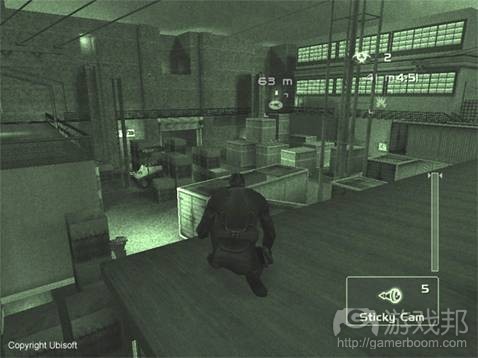



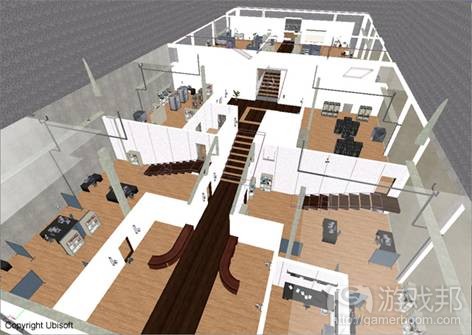

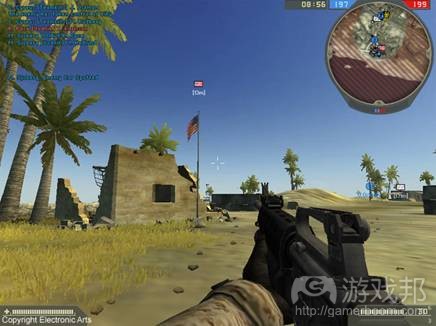
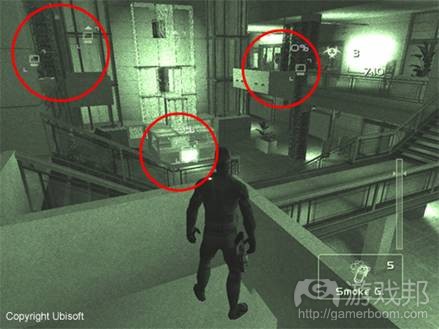

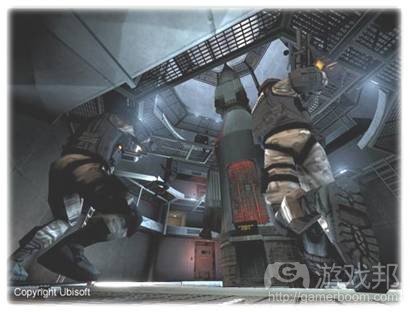
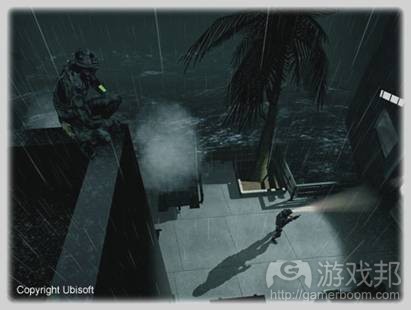
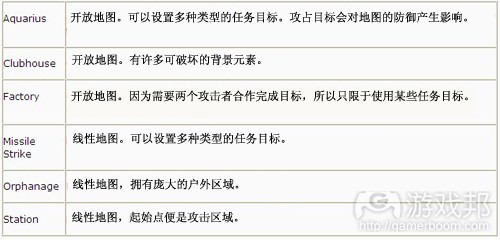
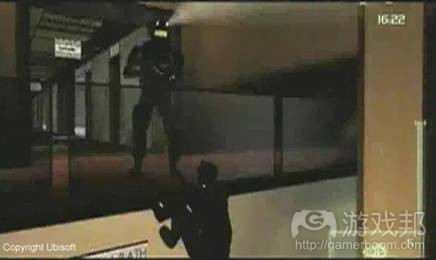
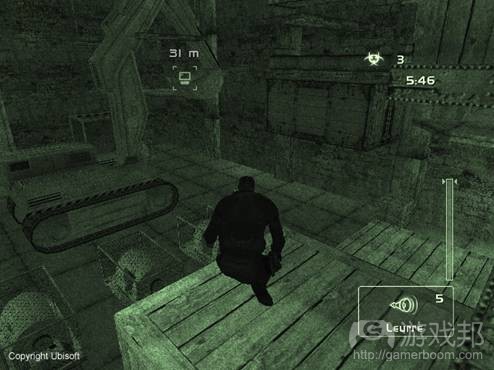















 闽公网安备35020302001549号
闽公网安备35020302001549号